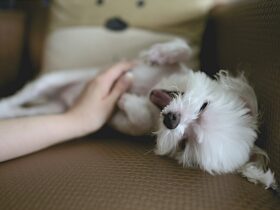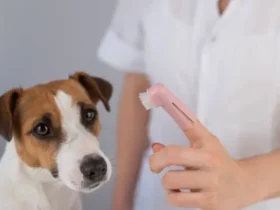Trimming your dog’s nails at home might seem like a daunting task, but with the right tools and techniques, it can become a straightforward and stress-free routine. Regular nail trimming is essential for your dog’s health, preventing painful overgrowth and potential injuries. Whether you’re new to dog grooming or looking to refine your skills, these pro tips will help you trim your dog’s nails safely and efficiently.
1. Understanding the Importance of Nail Trimming
1.1 Health Benefits
Proper nail trimming is crucial for your dog’s health and comfort. Overgrown nails can cause discomfort, affect their gait, and even lead to joint problems. Long nails can also break or splinter, leading to painful injuries. Regular trimming helps maintain proper paw function and overall well-being.
1.2 Identifying the Quick
The “quick” is the part of the nail that contains blood vessels and nerves. Trimming too close to the quick can cause pain and bleeding. Knowing where the quick is located helps prevent accidental injury.
2. Gathering the Right Tools
2.1 Nail Clippers
Choose the right type of nail clippers for your dog’s size and nail type:
- Guillotine Clippers: Ideal for small to medium-sized dogs. They have a blade that cuts through the nail with a guillotine-like action.
- Scissor Clippers: Suitable for larger dogs. They resemble scissors and provide more leverage for cutting thicker nails.
- Electric Nail Grinders: Useful for smoothing and filing nails. They can be less stressful for dogs who are anxious about clippers.
2.2 Nail File
A nail file or grinder can smooth out rough edges after clipping. This is especially helpful for dogs with brittle or sharp nails.
2.3 Styptic Powder
Styptic powder or a styptic pencil helps stop bleeding if you accidentally cut into the quick. It’s essential to have this on hand for emergencies.
3. Preparing Your Dog
3.1 Create a Calm Environment
Choose a quiet, well-lit area for nail trimming. Minimize distractions and ensure your dog is comfortable. Some dogs may feel more at ease on a non-slip mat or towel.
3.2 Familiarize Your Dog with the Tools
Introduce the clippers or grinder to your dog gradually. Let them sniff and investigate the tools before starting. Positive reinforcement, such as treats and praise, helps your dog associate the tools with a pleasant experience.
3.3 Positioning
Ensure you have a good view of your dog’s nails. For small dogs, you can hold their paw in your lap or on a flat surface. For larger dogs, you might need to use a grooming table or place them in a comfortable position where you can access their paws easily.
4. Trimming Techniques
4.1 Identify the Quick
In light-colored nails, the quick is visible as a pinkish area. In dark nails, it’s harder to see, so trim small amounts at a time to avoid cutting into the quick. If you’re unsure, trim gradually and check frequently.
4.2 Start Slowly
For the first few trims, it’s better to be conservative. Trim just the tip of the nail to avoid hitting the quick. You can always trim more in subsequent sessions.
4.3 Use Proper Technique
- Guillotine Clippers: Place the nail in the opening and squeeze the handle gently to cut the nail. Make sure to cut at a slight angle.
- Scissor Clippers: Position the nail between the blades and squeeze the handles together to clip the nail.
- Grinders: Gently grind the nail in small sections. Keep the grinder moving to prevent overheating.
4.4 Check for Splinters and Sharp Edges
After clipping, check the nails for any splinters or sharp edges. Use a nail file or grinder to smooth out any rough spots.
5. Handling Difficult Situations
5.1 Nervous or Anxious Dogs
If your dog is nervous about nail trimming, try to desensitize them gradually. Use treats and positive reinforcement to create a positive association. For very anxious dogs, consider consulting a professional groomer or veterinarian.
5.2 Bleeding Nails
If you accidentally cut the quick and cause bleeding, apply styptic powder to the affected nail. Apply gentle pressure until the bleeding stops. If bleeding persists, seek veterinary assistance.
6. Establishing a Routine
6.1 Frequency
The frequency of nail trimming depends on your dog’s activity level and nail growth rate. Typically, trimming every 3-4 weeks is a good rule of thumb. Regular trimming helps maintain nail health and prevents overgrowth.
6.2 Keep Records
Maintain a grooming log to track when you last trimmed your dog’s nails. This can help you establish a routine and ensure you stay on top of your dog’s nail care.
6.3 Professional Help
If you’re unsure about trimming your dog’s nails or if your dog is particularly difficult, don’t hesitate to seek help from a professional groomer or veterinarian. They can offer additional tips and techniques tailored to your dog’s needs.
7. Final Tips and Considerations
7.1 Be Patient and Gentle
Take your time during the nail trimming process. Patience and a gentle approach will help keep your dog calm and make the experience more pleasant for both of you.
7.2 Reward and Praise
After each successful trimming session, reward your dog with treats and praise. Positive reinforcement encourages good behavior and helps your dog look forward to grooming sessions.
7.3 Safety First
Always prioritize your dog’s safety. If you’re unsure about any aspect of nail trimming or if your dog shows signs of pain or discomfort, consult with a professional for guidance.
Conclusion
Trimming your dog’s nails at home can be a manageable and beneficial routine with the right approach. By following these pro tips, you’ll ensure that nail trimming becomes a positive experience for your dog and an essential part of their grooming regimen. Remember, regular nail care contributes significantly to your dog’s comfort and overall health.
Happy trimming!











Leave a Reply